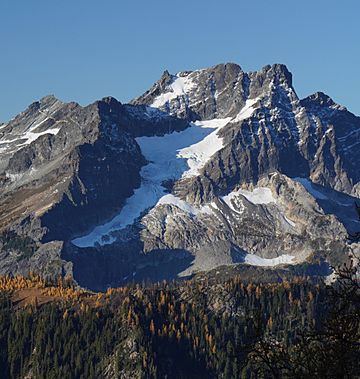Buck Mountain (Washington) facts for kids
Quick facts for kids Buck Mountain |
|
|---|---|

Buck Mountain, northeast aspect
|
|
| Highest point | |
| Elevation | 8,528 ft (2,599 m) |
| Prominence | 1,888 ft (575 m) |
| Isolation | 3.99 mi (6.42 km) |
| Parent peak | Clark Mountain (8,602 ft) |
| Geography | |
| Location | Chelan County, Washington, U.S. |
| Parent range | Cascade Range |
| Topo map | USGS Clark Mountain |
| Climbing | |
| First ascent | 1948 Carl Suback, Ray Rigg |
| Easiest route | Scrambling class 3 |
Buck Mountain is a tall mountain in Washington state. It stands 8,528-foot (2,599-metre) high, which is about 2.6 kilometers. This makes it a significant peak in the North Cascades mountain range.
You can find Buck Mountain inside the Glacier Peak Wilderness. It is located in Chelan County, within the Wenatchee National Forest. The mountain is close to other peaks like Clark Mountain and Brahma Peak.
Water from Buck Mountain flows into several rivers. These include Buck Creek, the Chiwawa River, and the Napeequa River. All these rivers eventually join the Wenatchee River. The mountain got its name from Albert Hale Sylvester. He was a surveyor and explorer who worked in the Cascades many years ago.
Contents
How Buck Mountain Was Formed
The North Cascades are known for their rugged look. They have sharp peaks, tall spires, and deep valleys carved by glaciers. These amazing shapes were created by geological events that happened millions of years ago.
Ancient Earth Movements
The story of the Cascade Mountains began millions of years ago. At that time, the North American Plate was slowly moving over the Pacific Plate. This movement caused many volcanic eruptions. One famous volcano, Glacier Peak, started forming about 9 miles (14.5 km) west of Buck Mountain.
Also, small pieces of the Earth's crust, called terranes, crashed together. This process helped create the North Cascades about 50 million years ago.
The Ice Age and Glaciers
During the Pleistocene period, which was over two million years ago, glaciers played a huge role. These massive ice sheets moved across the land many times. As they moved, they scraped away rock and left behind debris. This is why many river valleys in the area have a "U" shape.
Today, you can still see several glaciers on the slopes of Buck Mountain. The combination of land rising up (uplift) and cracks in the Earth (faulting), along with glaciation, formed the tall peaks and deep valleys we see today.
Buck Mountain's Weather
Buck Mountain is in a marine west coast climate zone. This means it gets a lot of influence from the Pacific Ocean. Most weather systems come from the Pacific and move towards the Cascade Range.
Rain and Snowfall
When these weather systems hit the North Cascades, the mountains force the air upward. This process is called Orographic lift. As the air rises, it cools and drops its moisture. This leads to a lot of rain or snow falling on the Cascades, especially on the western side.
Winters in this area see heavy snowfall. Because of the ocean's influence, the snow is often wet and heavy. This can increase the risk of avalanches.
Temperatures and Sunshine
Temperatures west of the Cascade Crest usually stay mild. They rarely drop below 0°F (–18°C) or go above 80°F (27°C). During winter, it's often cloudy. However, in summer, high-pressure systems over the Pacific Ocean bring clear skies. This means you can often enjoy sunny weather during the warmer months.




